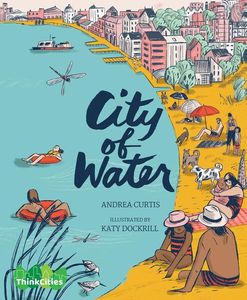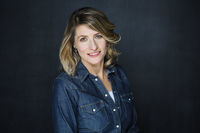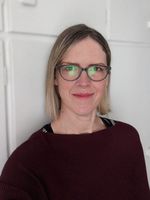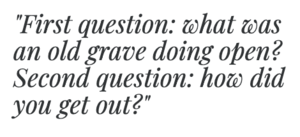City of Water Author & Artist Team Andrea Curtis and Katy Dockrill Offer a Fascinating Glimpse into the Writer-Illustrator Relationship
For those of us in cities, it's all too easy to take water for granted. Turn on a tap, and there it is. But the privilege of clean and reliable water requires vast and intricate work by many, and water is a finite resource. To help young readers understand how water reaches us and why it is essential for everyone to have access to clean water, author and illustrator team Andrea Curtis and Katy Dockrill created City of Water (Groundwood Books), the second book in the ThinkCities series (following A Forest in the City).
From the watershed to treatment facilities and municipal plumbing, as well as storm, sewer, and wastewater treatment systems, Curtis and Dockrill detail the dizzying journey that we rarely consider. Filled with kid-friendly fun water facts, it's a great way to talk about cities, the environment, and privilege with your young readers, including practical steps even small children can take to help out.
To celebrate City of Water, we're welcoming Andrea and Katy in conversation today, giving us a fabulous, intimate peek into the author-illustrator relationship, and getting to know them both as they put a twist on our Dirty Dozen challenge that asks creators to share 12 unexpected facts about themselves.
In chatting with one another, Andrea and Katy give us several delightful surprises and facts about themselves and their collaboration (even though they've never even met in person!), including their matching front doors, what they loved about each other's work on the book, and the travel daydreams that are getting them through the pandemic.
Andrea Curtis:
As someone who's worked on their own for many years, there’s nothing I like more than collaborating. And nothing better than seeing a kids’ book come together with a beautiful marriage of words and text. I feel so lucky to have been paired with you, Katy! I adore your illustrations and your hand-lettering style— the way you made City of Water feel like a living, breathing being, zooming in and out, combining people and landscape, even some gorgeous sea creatures. We have yet to meet in person so sharing a few surprising things about ourselves is a pretty fun way to get to know each other more. One thing I do know is that we live on opposite sides of the same city and that you and I both have the same yellow colour (a bit of mustard, a bit of daffodil) on our front doors! But I wonder if you know that City of Water is actually my third book about water? (Into the Blue: Family Secrets and the Search for a Great Lakes Shipwreck was my first, Big Water was my second). This is not my first time going to the, uh, well...
Katy Dockrill:
I was so happy when Groundwood approached me about City of Water because I loved the messaging and informative writing style that you brought to the book. And you had SO MUCH TO SAY about water! Which I gotta say, I love, because there was lots of interesting things to read about and gave me a chance to draw new things (like a water treatment plant!— the one in the book is based on North Toronto's Wastewater Treatment Plant, where I took my partner and daughter for a photo reference hike). Like you, Andrea, I work from home, and collaborating is usually me with my sketch books/computer/ipad/reference books, and a manuscript, so I'm embracing this conversation because we get to revel in the release of City of Water, and talk about it with each other! AND find out how much we have in common (yellow door, kids in school, common friends, LOVE OF WATER!).
AC:
That’s so great you did a field trip to the water treatment plant. I love that illustration! I also discovered it when I was researching and walking in the Toronto ravines. Which makes me think of another (possibly) surprising thing about me. Inspired by City of Water, I’ve been spending the pandemic attempting to walk the length of the Don River in Toronto. We take a different section each weekend and are trying to link it all together. It may just be a life’s work with three tributaries stretching all the way to the Oak Ridges Moraine. There are lots of established trails but we do a bit of off-roading, too. We’ve seen some amazing sights—from beautiful vistas of a surprisingly wide, rushing river to encampments and wooden shelters, vast mountain bike trails, a forest school, and a nunnery tucked in beside the river. Have you done anything surprising over this last strange year?
KD:
Maybe the biggest surprise for me is the comfort I get from routine, and how we’ve added more this past year. I have always worked from home, so that hasn’t changed, but because we have to distance, I started taking daily walks with my family, talking about whatever inspires us. We take the same route practically every day, and what I love about it is that it skirts part of Lake Ontario. Some days we make it all the way to the beach, where I can scour the shore for the best skipping rocks possible. We’ve seen so much more animal life, too. I’ve spotted a beautiful fox a few times, a lone coyote, a few possums, a hawk, families of skunks, large rats, mice, the usual raccoons, of course, fat robins and striking cardinal pairs. So many more people are taking advantage of the outdoors, hanging out in parks, walking and cycling instead of driving, it’s a really nice shift.
AC:
I so agree about discovering the joys of walking and soaking in the city around me but I have to say I really long to travel. I love to see this big, weird, amazing world. I once spent eight hours on the roof of a bus travelling through the jungles of Guatemala. It was really uncomfortable and terrifying but I think about that now with such nostalgia! Where will you go when we can go places again?
KD:
I’d love to go to any walkable city, just to revel in architecture, sip coffee, and draw some new things. My last major trip took us through Europe, and my favourite part was walking between the cities of Cinque Terre in Italy, cliffside with precarious footing, lit only by moonlight. THAT was terrifying but exhilarating. On my list of places I’d love to go are Costa Rica, Oaxaca City, and cycling in Copenhagen.
Your CanLit News
Subscribe to Open Book’s newsletter to get local book events, literary content, writing tips, and more in your inbox
AC:
That sounds fabulous. I sometimes think dreaming about travelling and remembering it later is almost as good as the travelling itself. There are lots of things like that for me. I think back to one of my hardest jobs—treeplanting during university for three summers—with great fondness, but it was actually backbreaking, bug-bitten hell at the time. What was your strangest job?
KD:
OMG, I always wanted to treeplant, but was rejected! But hey, if that didn’t happen, I would not have found my job at the cemetery. Endless summers of plot care, finding ways to evade our boss who used to drive her red car around trying to keep an eye on us, oh and I actually fell into an old grave! So many questions now, right??
AC:
First question: what was an old grave doing open? Second question: how did you get out?
KD:
Well, funny you should ask! It wasn’t fully open, the ground just gave way while I was walking across that section, so one leg fell in up to my upper thigh. Thankfully one of the other part-timers was walking beside me, so I got out and told the full-time crew to fill it in. In the meantime, we had a shovel with us, and poked around below to figure out the actual depth. Our general sense was that it was squishy....but, I mean, falling through ground was my worst nightmare up until then, and now it’s not!
AC:
My worst nightmare probably involves snakes. I am not a fan though I know more about the endangered venomous Massassauga rattlesnake than some. I’ve spent a lot of time on Georgian Bay in Massassauga territory and even included a rattler in my book, Big Water (the heroine narrowly escapes a snake strike). I know these snakes mostly just want to sun themselves and procreate but fear isn’t rational! Do you use your art to work through your own fears, hopes, dreams?
KD:
Interesting question. I’m not sure taking on jobs because they scare me qualifies as an answer here, but that is totally what I do. I once illustrated a book, Where’s Jane (as in Jane Austen) in a similar fashion to a Where’s Waldo book. Thinking back, I cannot believe I was able to complete those illustrations, full of people, in different poses, buildings I didn’t know, outfits I wasn’t familiar with, feet in shoes, odd angles, and all in a timely fashion. It was totally stressful, but I really learned so much about myself and what I can do if I just keep at it.
My hopes and dreams are to continually draw for a living, it’s really been a gift so far, and am so thankful for every single job that comes my way. How about you? What other stories do you want to tell? Where do your ideas stem from?
AC:
Ideas come to me in images, in disembodied words, they show up unannounced and wriggle their way into my consciousness until I can’t ignore them any longer. Sometimes they become a character or a place or a concept. I write in many different genres (both for kids and adults, fiction and nonfiction) and I have wondered sometimes if there’s an obvious through-line. I’ve come to the conclusion that curiosity is the crooked, knobbly spine holding it all together. From there, I follow my interest in trees and water and food, in motherhood and friendship, history, politics and how to be a person in the world! I’m currently working on an adult novel about a young woman who discovers she’s a foundling, a YA novel about a girl whose mother disappears during a mental health crisis, a picture book about a kid who asks too many questions and another about a child who dreams of the stars. And, oh yeah, another couple books in the Groundwood ThinkCities series! What are you working on these days?
KD:
Makes me think your mind is like a winding stream, always running, but with unexpected changes and no end in sight (meaning you’ll never run out!).
As for me, I think I’ve opened a can of worms with the books I’ve done, because I’m currently working on a bunch. One about how humans have found fun through the ages (Orca), and another about WWII facts, a murder mystery cover for a series I’ve done with Harlequin, a cover for Simon & Schuster teen travel story and a few editorial pieces. Drawing has been a great distraction from the pandemic. It’s a crazy time in history right now, everything kind of had to stop, or change direction, and as much as it’s been chaotic and distressing in so many ways, it also feels like there has been a shift to calmness—maybe because there aren’t many things to do! On that note, I gotta go—my kid wants to go for a walk!
____________________________________________________
Andrea Curtis writes books for both children and adults. Her children’s non-fiction titles include A Forest in the City, illustrated by Pierre Pratt; Eat This! (starred reviews from Kirkus and School Library Journal) and What’s for Lunch? (VOYA’s Honor List). She has also written the young adult novel Big Water and teaches creative writing to kids. Andrea lives with her family in Toronto where she grows vegetables, wanders the ravines, and spends as much time as possible on her bike.
Katy Dockrill is an honours graduate from Ontario College of Art and Design. Her fresh brush-and-ink illustrations have attracted a wide range of clients, and she has won a number of awards for her editorial work. She has illustrated A Voice for the Spirit Bears by Carmen Oliver, among other titles, as well as many covers for children’s novels. Katy lives with her family in Toronto, where she loves swimming, gardening, and taking walks with her daughter.







